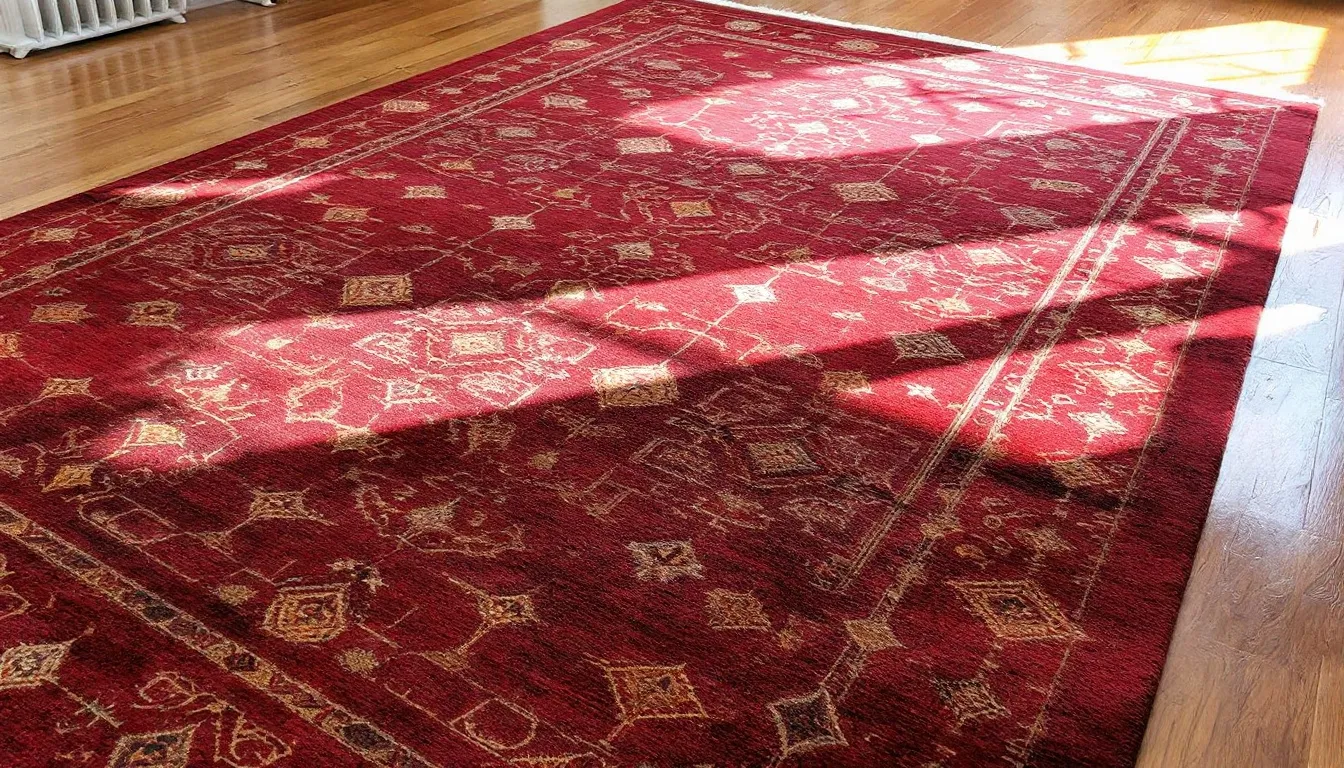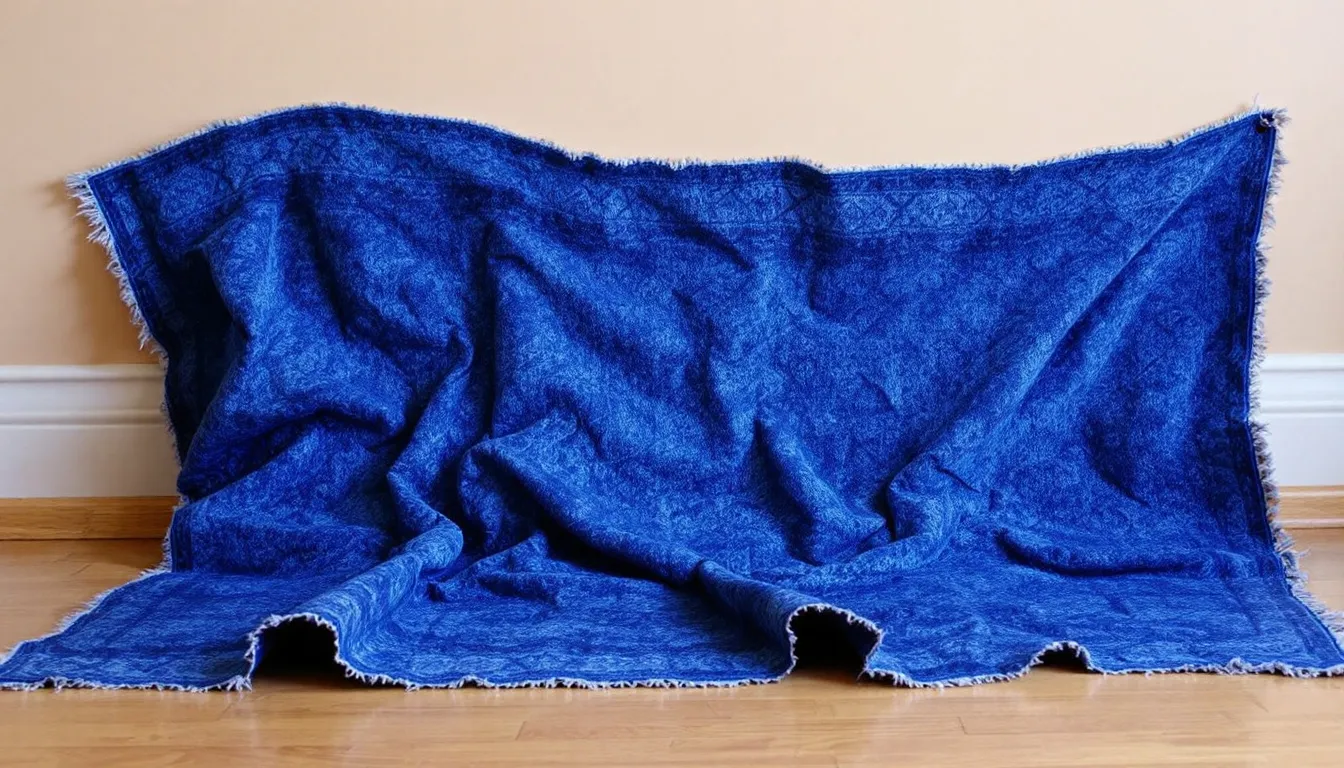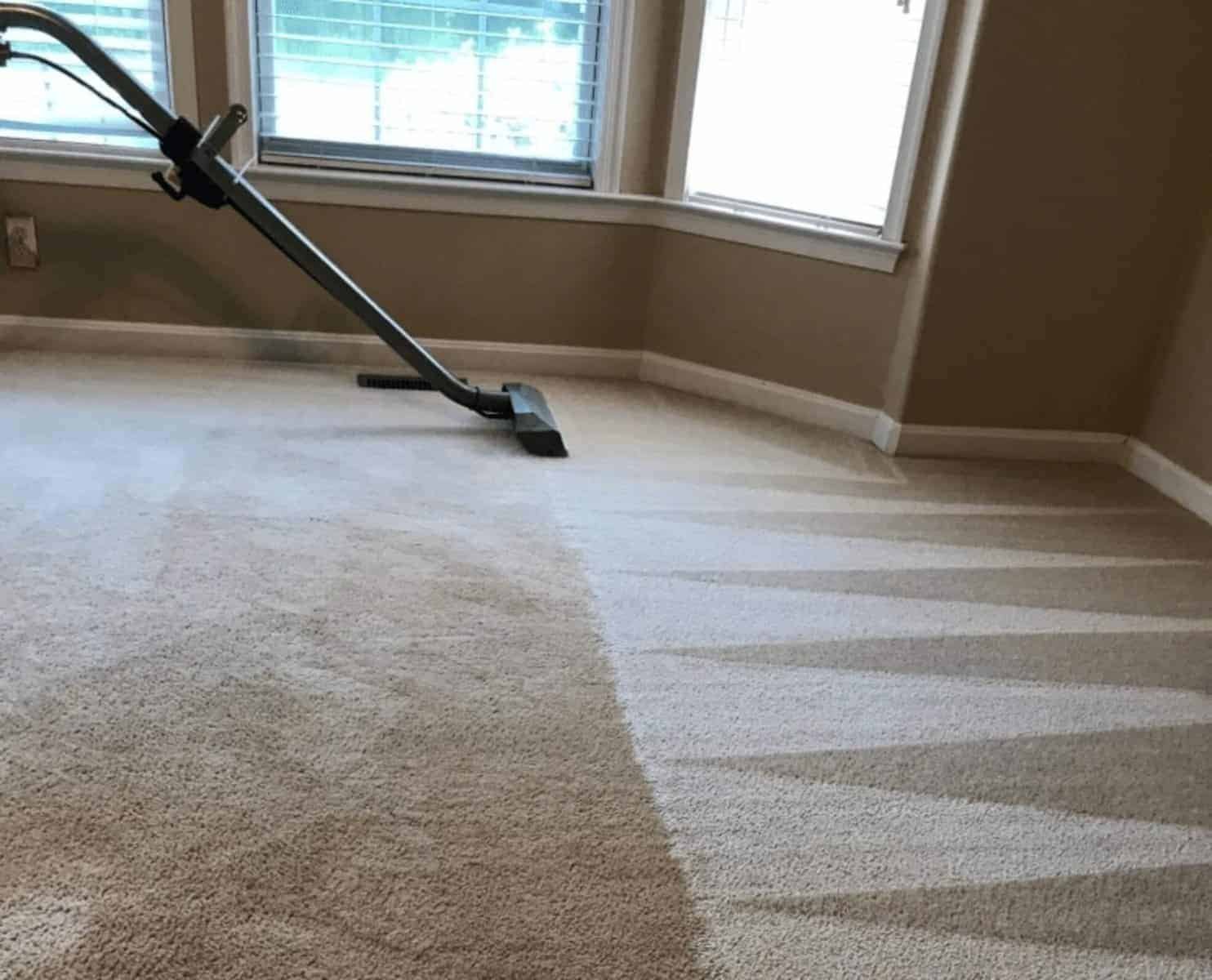Get Wrinkles Out of a Polypropylene Rug

What Are Polypropylene Rug Wrinkles and How To Get Wrinkles Out of a Polypropylene Rug
Getting wrinkles out of a polyprop. rug is essential for safety, appearance, and rug longevity. In this guide, you’ll learn the safest methods to flatten your rug, why polypropylene requires special care, and step-by-step techniques that work without damaging your investment.
Wrinkles, curling edges, and creases are common issues with polypropylene rugs and are not something to worry about. With the right methods, you can easily fix curling or creased areas and restore your rug’s appearance.
This comprehensive guide covers polyprop. material properties, safe removal methods, required tools, and troubleshooting tips for stubborn creases. Whether you’re dealing with a new rug fresh from shipping or an area rug that’s developed wrinkles over time, these proven techniques will help you achieve a perfectly flat result.
Polyprop. rugs commonly develop wrinkles from shipping and storage practices. Manufacturers roll or fold these area rugs tightly for transport, creating persistent creases that resist laying flat naturally. Additional wrinkles can form from improper washing, storage in tight spaces, or normal wear patterns that cause the material to hold unwanted shapes. Edges or corners may also curl up, creating additional challenges for keeping your rug flat and safe.
Understanding Polypropylene Rugs: Material Properties and Wrinkle Types
Polypropylene Material Characteristics
Polyprop. is a synthetic fiber widely used in both outdoor and indoor area rugs due to its exceptional durability and water resistance. This thermoplastic polymer exhibits heat sensitivity with a melting point around 160°C (320°F), making it significantly more vulnerable to heat damage than natural fibers like wool or cotton.
The fibers demonstrate shape memory, meaning they tend to retain their rolled or folded positions unless properly treated. This characteristic makes poly rugs prone to persistent wrinkles but also responsive to gentle correction methods when heat and moisture are applied carefully.
Common Types of Wrinkles and Creases
Shipping creases form when rugs are folded or rolled tightly during transport, creating sharp lines that run across the carpet’s surface. These are the most common type of wrinkle encountered with new area rugs.
Corner curling occurs when rug edges refuse to lay flat against the floor, often developing from storage or age-related fiber memory. This creates trip hazards and an unprofessional appearance in living spaces.
Center fold lines appear as prominent creases running down the middle of the rug, typically from packaging methods that fold the carpet in half. Edge buckling can develop from improper washing or drying techniques that cause sections of the rug to pucker or wave.
Causes of Wrinkles in Polypropylene Rugs
Polyprop. rugs are especially susceptible to developing wrinkles and creases, both during shipping and once they’re in your home. The most common cause is the way these area rugs are folded and rolled for transport—tight rolling or folding can leave a pronounced crease running down the middle of the rug. When a polypropylene rug is exposed to heat or moisture, the synthetic fibers can become more pliable, making them even more likely to hold onto these creased shapes. After being unrolled, the rug may not immediately lay flat, and the wrinkles can persist, especially if the rug was stored in a rolled or folded position for an extended period. Even everyday factors, like moving the rug from room to room or placing it on an uneven surface, can contribute to new wrinkles forming. Understanding these causes helps you choose the right methods to remove creases and keep your polyprop. rug looking smooth and flat in any space.
Why Removing Wrinkles from Polypropylene Rugs is Important
Safety concerns top the priority list when addressing rug wrinkles. Raised edges and corners create trip hazards that can cause falls, particularly dangerous for elderly residents or young children. The National Safety Council has reported that falls account for over eight million emergency room visits every year, with uneven floor surfaces contributing significantly to these incidents. It is important to eliminate wrinkles and creases to eliminate trip hazards and maintain a safe environment.
Aesthetic benefits extend beyond mere appearance. A smooth, flat rug creates a professional look in any room and allows furniture to sit properly without rocking or gaps. Wrinkled area rugs can make even well-decorated spaces appear neglected or carelessly maintained.
Rug longevity improves dramatically when wrinkles are addressed promptly. Persistent creases can become permanent if left untreated, as the polyprop. fibers gradually accept their distorted shape as the new normal. Early intervention prevents costly replacement and maintains your rug’s original appearance for years.
Initial Flattening Methods for a New Polypropylene Rug
When you first bring home a new polypropylene rug, it’s normal to notice some wrinkles or creases from being tightly rolled or folded during shipping. To help your rug lay flat, start by unrolling it on a hard surface like hardwood or concrete and let it sit for a few hours. This gives the fibers a chance to relax and begin to flatten naturally. For more stubborn creases, try the reverse rolling method: roll the rug in the opposite direction of how it was shipped, then let it rest in this position for a while to help loosen the fibers and remove creases. You can also place heavy objects, such as heavy books or pieces of furniture, on the wrinkled areas to encourage the rug to flatten out. If the wrinkles persist, using a steam cleaner with a little moisture can help relax the polypropylene fibers—just be sure to use the steam sparingly and avoid soaking the rug. With patience and the right method, your rug will soon be flat and ready to enhance any room.
Wrinkle Removal Methods Comparison Table
| Method | Effectiveness | Time Required | Safety Level | Tools Needed |
|---|---|---|---|---|
| Reverse Rolling | High | 48-72 hours | Very Safe | None |
| Steam Treatment | Very High | 2-4 hours | Moderate* | Iron, damp towel |
| Weighted Flattening | Moderate | 24-48 hours | Very Safe | Heavy books/objects |
| Natural Relaxation | Low-Moderate | 3-7 days | Very Safe | None |
| Sun Exposure | Moderate | 4-8 hours | Safe** | None |
Requires careful temperature control to prevent melting *May cause color fading with prolonged exposure
Step-by-Step Guide to Removing Wrinkles from Polypropylene Rugs
Step 1: Assess the Rug and Prepare Your Workspace
Begin by unrolling your polyprop. rug completely and identifying the severity and location of each crease. Take note of whether wrinkles are shallow surface impressions or deep fold lines that create raised areas.
Gather your tools: heavy books or furniture for weight, a steam iron with variable heat settings, clean damp towels, and access to a flat, hard surface like hardwood flooring or concrete. Avoid working on thick carpet, as it won’t provide adequate support for flattening techniques.
Test colorfastness in an inconspicuous corner before proceeding with any moisture-based methods. Apply a small amount of warm water and verify that colors don’t bleed or fade. This verification step prevents damage to the visible areas of your rug.
Step 2: Apply Safe Heat Methods for Polypropylene
Set your iron to the lowest steam setting and allow it to heat up completely. Place a damp towel over the wrinkled area, ensuring the fabric covers the entire crease plus a few inches on each side for protection.
Hold the iron 6 inches above the towel and apply gentle steam for 3-5 seconds before moving to an adjacent area. Never allow the iron to make direct contact with polypropylene fibers, as temperatures above 160°C will cause immediate melting and permanent damage.
Work systematically across each wrinkle, keeping the iron in constant motion. Check your progress frequently by lifting the towel and examining the rug’s response. The heat and moisture combination helps polypropylene fibers relax and return to their original flat position.
Step 3: Use Mechanical Flattening Techniques
Implement the reverse roll method by rolling your rug in the opposite direction from its shipping configuration. Secure the rolled rug with tape and let it sit for 48-72 hours, allowing the fibers to develop memory in the correct direction.
Apply strategic weight placement using heavy books or furniture pieces. Position weights directly over persistent creases and leave them in place for at least 24 hours. This method works particularly well for corner curling and edge buckling issues.
For center fold lines, try laying the rug on a hard surface and walking on the creased areas while wearing clean shoes. The combination of body weight and slight stretching motion helps loosen stubborn fiber memory without damaging the material.
Common Mistakes to Avoid When Flattening Polypropylene Rugs
Mistake 1: Using excessive heat that melts polypropylene fibers. Direct contact with hot irons or steam cleaners can permanently damage synthetic materials. Always use protective barriers and low heat settings when applying steam treatments.
Mistake 2: Applying too much moisture causing mold or mildew. While little moisture helps relax fibers, soaking the rug creates ideal conditions for bacterial growth. Use damp (not wet) towels and ensure complete drying before normal use.
Mistake 3: Rushing the process and not allowing adequate drying time. Polypropylene requires time to respond to heat and pressure treatments. Expecting immediate results often leads to aggressive techniques that damage the rug’s structure.
Mistake 4: Using harsh chemicals or cleaners during the wrinkle removal process. Chemical interactions can weaken polypropylene fibers and cause unexpected color changes. Stick to water-based treatments and avoid cleaning products during flattening procedures.
Pro Tip: Always test your chosen method on a small, hidden area first. This verification process reveals any adverse reactions before treating visible portions of your area rug.
Preventing Future Wrinkles in a Polypropylene Rug
Keeping your polyprop. rug smooth and wrinkle-free is all about prevention and proper care. Start by using a non-slip underlay to keep the rug securely in place on the floor, which helps prevent curling and wrinkling at the edges. Applying rug tape or double-sided tape in high-traffic areas can also keep the rug flat and stop it from shifting or bunching up. Regular cleaning is important, but avoid using excessive heat or moisture, as this can cause the fibers to shrink or become misshapen. Instead, spot clean with a damp towel and use gentle cleaning methods to maintain the rug’s smooth appearance. By taking these simple steps, you can prevent your polyprop. rug from becoming wrinkled or curled, ensuring it stays flat and looks great in your home.
Rug Care and Maintenance Tips for Polyprop. Rugs
To keep your polyprop. rug looking its best and prevent wrinkles, follow a few simple care and maintenance tips. Vacuum your rug regularly using a gentle suction setting to remove dirt and debris without damaging the fibers. Avoid placing your rug in direct sunlight, as prolonged exposure can cause the colors to fade and the fibers to become brittle. When cleaning up spills or stains, use a mild cleaning product and blot the area with a towel—never rub, as this can damage the fibers and create new creases. For tougher stains, a steam cleaner can be used to add a little moisture and help loosen dirt, but always use steam sparingly to avoid over-wetting the rug. Rotate your rug every few months to ensure even wear, and use furniture leg protectors to prevent dents and scratches. By following these tips, you’ll help your polypropylene rug stay smooth, flat, and beautiful for years to come.
Real-Life Example: Removing Shipping Creases from an 8×10 Polyprop. Rug
A family recently purchased a new outdoor polyprop. rug for their patio space. Upon delivery, they discovered a prominent 3-inch high center crease that prevented the rug from laying flat and created a significant trip hazard near their outdoor furniture.
The starting situation involved a sharp fold line running the entire 10-foot length of the rug. Traditional methods like laying heavy objects on the crease showed minimal improvement after 24 hours, prompting them to try more intensive techniques.
Their solution combined multiple approaches: they began with reverse rolling for 48 hours, followed by gentle steam treatment using a damp towel and iron on the lowest setting. Finally, they placed heavy books along the treated crease and weighted the corners with outdoor furniture.
The results exceeded expectations. After 5 days of patient treatment, the rug lay completely flat with no visible creases or raised areas. The family now enjoys their outdoor space without safety concerns, and the rug maintains its original appearance with no heat damage or fiber distortion.
Also read about: Secrets To Elevate Your Alexandria Home Carpet Cleaning Services

FAQs About Getting Wrinkles Out of Polyprop. Rugs
Q1: Can I use a regular iron directly on polypropylene rugs? A1: No, direct heat will melt polypropylene fibers and cause permanent damage. Always use a damp protective towel and keep your iron on the lowest heat setting to prevent melting.
Q2: How long does it take to remove shipping creases? A2: Most creases flatten within 3-7 days using proper techniques. Severe creases from tight rolling may require up to 2 weeks of patient treatment with multiple methods.
Q3: Will washing my polypropylene rug remove wrinkles? A3: Washing can help relax fibers, but you must ensure the rug dries completely flat to prevent new creases from forming. Use a hard surface for drying rather than hanging or folding.
Q4: Is it safe to use steam cleaners on polypropylene rugs? A4: Yes, but use the upholstery attachment and keep the device moving constantly to avoid concentrated heat in one area. Test the temperature on a corner before treating visible areas.
Q5: What should I do if my rug develops dents from furniture? A5: Place ice cubes on the dents and allow them to melt slowly. The moisture and gentle pressure help polypropylene fibers return to their original height and shape.
Conclusion: Key Takeaways for Wrinkle-Free Polyprop. Rugs
The four most effective methods for removing wrinkles from polypropylene rugs are reverse rolling, gentle steam treatment with protective towels, weighted flattening with heavy objects, and strategic ice treatment for stubborn dents. Each technique works by relaxing the synthetic fibers without exposing them to damaging temperatures.
Remember that patience and proper technique matter more than speed when working with heat-sensitive polypropylene material. The low melting point of these synthetic fibers requires careful attention to temperature control and protection methods during any steam or heat application.
Take immediate action after receiving a new rug to prevent creases from becoming permanent. The longer wrinkles remain untreated, the more difficult they become to remove as the polyprop. fibers accept their distorted shape as normal.
For future wrinkle prevention, store your rugs flat when possible and avoid folding or tight rolling. When cleaning is necessary, always lay the rug flat on a hard surface during the drying process to maintain its smooth appearance and extend its useful life in your home.


